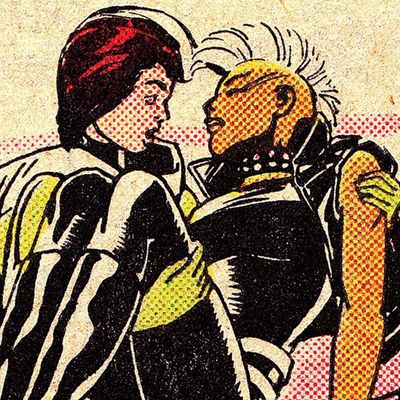
In 1994, shortly after her 19-year-old brother died of leukemia, a young woman wrote a letter addressed to “the creators of the X-Men comics.” In it, she recounted how days before his death her brother had come out to her, confessing how deeply unhappy he was. His sexual orientation, he said, was also why he had always liked the X-Men. “He hated himself because he was gay,” she wrote. “He was a mutant.” He saw himself in Beast, in Rogue, in Iceman. The letter, published in Uncanny X-Men #317, wasn’t the first time that group of misfits would be seen through the lens of a queer identity, nor would it be the last.
This year at Flame Con, New York’s queer-comics convention, legendary X-Men scribe Chris Claremont attempted to address the queer embrace of his comic — or, as Andrew Wheeler, editor-in-chief of Comics Alliance has put it, while “LGBT people couldn’t be part of the X-Men’s text, the experiences of LGBT people came to dominate the X-Men’s subtext.” “As stupid as it sounds, it was never there in my head so it was weird to see other people reacting that way,” Claremont said on the panel Pride and the X-Men. “But, well, my thought was, God bless ambiguity.” The other panelists including openly gay comic-book artists Phil Jimenez and Tania Ford, and Geeks OUT moderator, Josh Siegel would try to tease out the subtext from the text, but Claremont demurred: There was never an active attempt to make characters stand-ins for the plight of the LGBT community.
Regardless of whether Claremont intended the X-Men to serve as a metaphor for the queer experience, many queer readers read it that way. Claremont, of course, is perfectly fine with that. Alongside writer/artist John Byrne, Claremont shaped the 1970s overhaul of the mutant group in ways that made nonconformity their most salient feature. Where the original group of X-Men were a handful of suburban white guys (and one girl), the revamped team launched in 1975 featured characters like Storm, Nightcrawler, and Thunderbird who visually and dramatically realized the central tenet of the comics: Mutants were different.
“What they were seeing was the life as it was happening, and each could draw a legitimate and valid conclusion based on what they saw and how they felt that spoke to them as a reader,” Claremont told Vulture ahead of the panel. Indeed, just walking around Flame Con, the influence of the X-Men was undeniable. There was a table of prints featuring a deliciously sculpted Gambit, two Storm cosplayers fawning over their respective costumes — one a take on the classic white jumpsuit, the other a riff on the character’s ‘80s punk look — and gender-bent versions of Rogue, Jubilee, Mystique, and Emma Frost. The X-Men were, after all, a group of outsiders from all over the world whose very difference empowers and alienates them. What may have started as a coded sense of difference has instead turned into a celebration at places like Flame Con.
“The Comics Code tried to restrict everything,” Claremont said about the self-regulating system for censoring comic books. “But with a certain measure of visual subtlety and ambiguity you could actually achieve everything you wanted.” In fact, Claremont spoke at length about the way his writing often circled pressing social issues while staying within the constraints of a mainstream publication. He cited an issue of The New Mutants that followed Larry, a young male mutant arriving at a new school. He feels uneasy given the anti-mutie sentiment that greets him there, and tragically, takes his own life.
Addressing Larry’s school shortly thereafter, one of the X-Men, Kitty Pryde, who’d met Larry the night before he killed himself, voices a heartfelt plea on behalf of teenagers like him. “He thought if people knew the truth, they’d stop seeing him and see only the label, the brand, his personal ‘Scarlet Letter,’” she says holding back tears. “So he hid the truth and lived in terror of being discovered.” Despite reading like something we would see now on social media, Larry’s story was published on November 1986 and never explicitly addressed itself to gay readers. But it’s no surprise, Claremont added, that “gay people could look at it and find resonance in terms of who they were and what they were standing for.”
Now the subtext has been brought to the fore with the changing cultural tides. Openly gay director Bryan Singer made the analogy an inescapable part of X-Men’s legacy with a scene where Iceman (Shawn Ashmore) “comes out” as a mutant to his parents in X2 (a moment made all the more prescient given the character’s recent reveal in the comics). As Ian McKellen has noted, it was on the strength of that thematic thread that the director pitched the project to him and one of the reasons the actor felt compelled to sign on to play Magneto in the first place. In the cheekily titled webcomic “The X-Men Made Me Gay,” writer and illustrator John Leavitt puts it more simply: Once the characters transitioned onto the big screen, “the subtext was not subtle.”
Winding through male Mystiques and female Magnetos at this year’s Flame Con, it was clear that queer subtext had triumphed. Here was a jubilant display of the impact these characters have had on the queer community (and vice versa), but, perhaps more accurately, of the importance of queer reading practices. And rather than protest, or worse yet, take ownership of the work gay fans have done for themselves in appropriating the X-Men, Claremont seemed happy to acknowledge how little of the X-Men’s queerness had started with him. He offered instead a quiet if radical call to arms — that the text could be whatever the reader makes it. “You know there’s a space between every panel,” he winkingly told the audience. “You can go wherever you want. And who am I to get in the way?”

